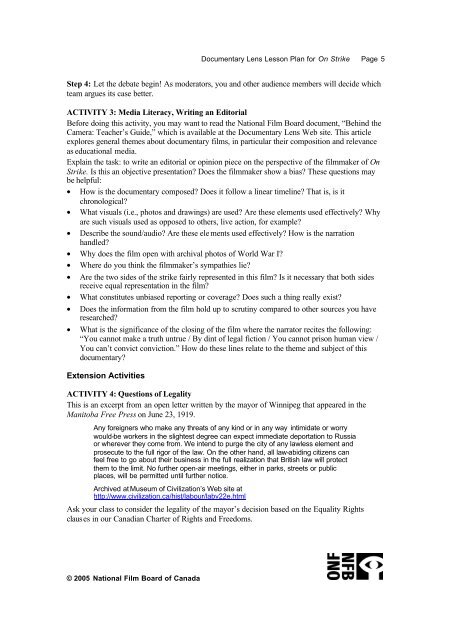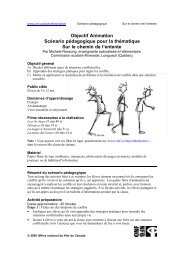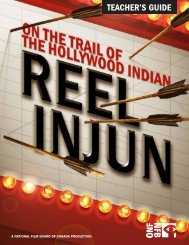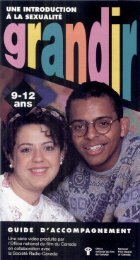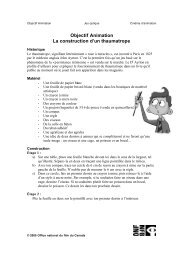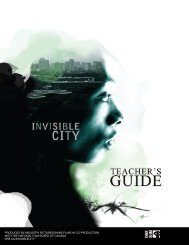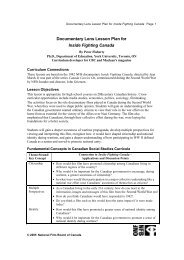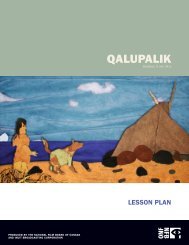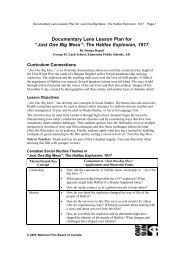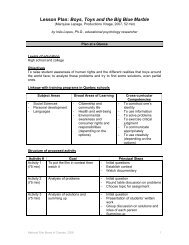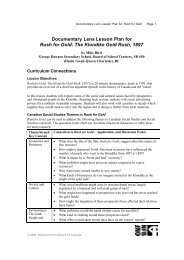Documentary Lens Lesson Plan for On Strike - Office national du film ...
Documentary Lens Lesson Plan for On Strike - Office national du film ...
Documentary Lens Lesson Plan for On Strike - Office national du film ...
You also want an ePaper? Increase the reach of your titles
YUMPU automatically turns print PDFs into web optimized ePapers that Google loves.
<strong>Documentary</strong> <strong>Lens</strong> <strong>Lesson</strong> <strong>Plan</strong> <strong>for</strong> <strong>On</strong> <strong>Strike</strong> Page 5Step 4: Let the debate begin! As moderators, you and other audience members will decide whichteam argues its case better.ACTIVITY 3: Media Literacy, Writing an EditorialBe<strong>for</strong>e doing this activity, you may want to read the National Film Board document, “Behind theCamera: Teacher’s Guide,” which is available at the <strong>Documentary</strong> <strong>Lens</strong> Web site. This articleexplores general themes about documentary <strong>film</strong>s, in particular their composition and relevanceas e<strong>du</strong>cational media.Explain the task: to write an editorial or opinion piece on the perspective of the <strong>film</strong>maker of <strong>On</strong><strong>Strike</strong>. Is this an objective presentation? Does the <strong>film</strong>maker show a bias? These questions maybe helpful:• How is the documentary composed? Does it follow a linear timeline? That is, is itchronological?• What visuals (i.e., photos and drawings) are used? Are these elements used effectively? Whyare such visuals used as opposed to others, live action, <strong>for</strong> example?• Describe the sound/audio? Are these ele ments used effectively? How is the narrationhandled?• Why does the <strong>film</strong> open with archival photos of World War I?• Where do you think the <strong>film</strong>maker’s sympathies lie?• Are the two sides of the strike fairly represented in this <strong>film</strong>? Is it necessary that both sidesreceive equal representation in the <strong>film</strong>?• What constitutes unbiased reporting or coverage? Does such a thing really exist?• Does the in<strong>for</strong>mation from the <strong>film</strong> hold up to scrutiny compared to other sources you haveresearched?• What is the significance of the closing of the <strong>film</strong> where the narrator recites the following:“You cannot make a truth untrue / By dint of legal fiction / You cannot prison human view /You can’t convict conviction.” How do these lines relate to the theme and subject of thisdocumentary?Extension ActivitiesACTIVITY 4: Questions of LegalityThis is an excerpt from an open letter written by the mayor of Winnipeg that appeared in theManitoba Free Press on June 23, 1919.Any <strong>for</strong>eigners who make any threats of any kind or in any way intimidate or worrywould-be workers in the slightest degree can expect immediate deportation to Russiaor wherever they come from. We intend to purge the city of any lawless element andprosecute to the full rigor of the law. <strong>On</strong> the other hand, all law-abiding citizens canfeel free to go about their business in the full realization that British law will protectthem to the limit. No further open-air meetings, either in parks, streets or publicplaces, will be permitted until further notice.Archived at Museum of Civilization’s Web site athttp://www.civilization.ca/hist/labour/labv22e.htmlAsk your class to consider the legality of the mayor’s decision based on the Equality Rightsclauses in our Canadian Charter of Rights and Freedoms.© 2005 National Film Board of Canada


